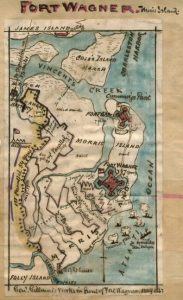“I helped…to pack haversacks and cartridge boxes”

Susie King Taylor accompanied the 33rd United States Colored Troops (originally designated as the 1st South Carolina Volunteer Infantry Regiment) during their service. Her husband served in the unit, and she was officially listed as a laundress, though she also worked as a nurse and teacher and had other adventures along the way. Later, she wrote a book and self-published it in 1902: Reminiscences of My Life in Camp with the 33d United States Colored Troops, Late 1st S.C. Volunteers. The book is available online through the program Documenting The South at the University of North Carolina at Chapel Hill.
Here is an excerpt about the regiment’s attack in summer 1864 and the aftermath according to Susie King Taylor:

The regiment under Colonel Trowbridge did garrison duty, but they had troublesome times from Fort Gregg, on James Island, for the rebels would throw a shell over on our island every now and then. Finally orders were received for the boys to prepare to take Fort Gregg, each man to take 150 rounds of cartridges, canteens of water, hard-tack, and salt beef. This order was sent three days prior to starting, to allow them to be in readiness. I helped as many as I could to pack haversacks and cartridge boxes.
The fourth day, about five o’clock in the afternoon, the call was sounded, and I heard the first sergeant say, “Fall in, boys, fall in,” and they were not long obeying the command. Each company marched out of its street, in front of their colonel’s headquarters, where they rested for half an hour, as it was not dark enough, and they did not want the enemy to have a chance to spy their movements. At the end of this time the line was formed with the 103d New York (white) in the rear, and off they started, eager to get to work. It was quite dark by the time they reached Pawnell Landing. I have never forgotten the good-bys of that day, as they left camp. Colonel Trowbridge said to me as he left, “Good-by, Mrs. King, take care of yourself if you don’t see us again.” I went with them as far as the landing, and watched them until they got out of sight, and then I returned to the camp. There was no one at camp but those left on picket and a few disabled soldiers, and one woman, a friend of mine, Mary Shaw, and it was lonesome and sad, now that the boys were gone, some never to return.
Mary Shaw shared my tent that night, and we went to bed, but not to sleep, for the fleas nearly ate us alive. We caught a few, but it did seem, now that the men were gone, that every flea in camp had located my tent, and caused us to vacate. Sleep being out of the question, we sat up the remainder of the night.
About four o’clock, July 2, the charge was made. The firing could be plainly heard in camp. I hastened down to the landing and remained there until eight o’clock that morning. When the wounded arrived, or rather began to arrive, the first one brought in was Samuel Anderson of our company. He was badly wounded. Then others of our boys, some with their legs off, arm gone, foot off, and wounds of all kinds imaginable. They had to wade through creeks and marshes, as they were discovered by the enemy and shelled very badly. A number of the men were lost, some got fastened in the mud and had to cut off the legs of their pants, to free themselves. The 103d New York suffered the most, as their men were very badly wounded.
My work now began. I gave my assistance to try to alleviate their sufferings. I asked the doctor at the hospital what I could get for them to eat. They wanted soup, but that I could not get; but I had a few cans of condensed milk and some turtle eggs, so I thought I would try to make some custard. I had doubts as to my success, for cooking with turtle eggs was something new to me, but the adage has it, “Nothing ventured, nothing done,” so I made a venture and the result was a very delicious custard. This I carried to the men, who enjoyed it very much. My services were given at all times for the comfort of these men. I was on hand to assist whenever needed. I was enrolled as company laundress, but I did very little of it, because I was always busy doing other things through camp, and was employed all the time doing something for the officers and comrades.
After this fight, the regiment did not return to the camp for one month. They were ordered to Cole Island in September, where they remained until October. (Pages 32-33)

I was excited to see this post about Susie King Taylor, I had recently purchased her “Reminiscences of My Life in Camp with the 33d United States Colored Troops, Late 1st S.C. Volunteers”. My Great-Great-Grandfather Enoch W. Robbins was a Captain in that regiment, from Maine. Thank you for this contribution to our history.
Lovely perspective. Thank you for posting this.